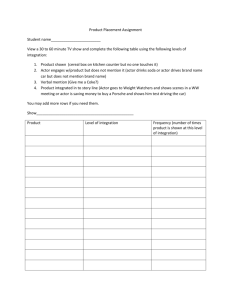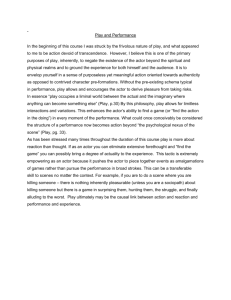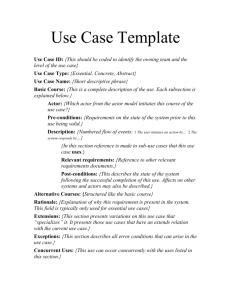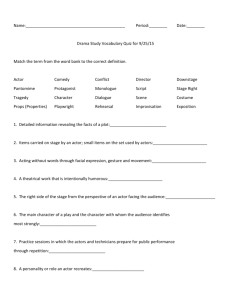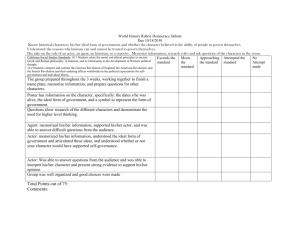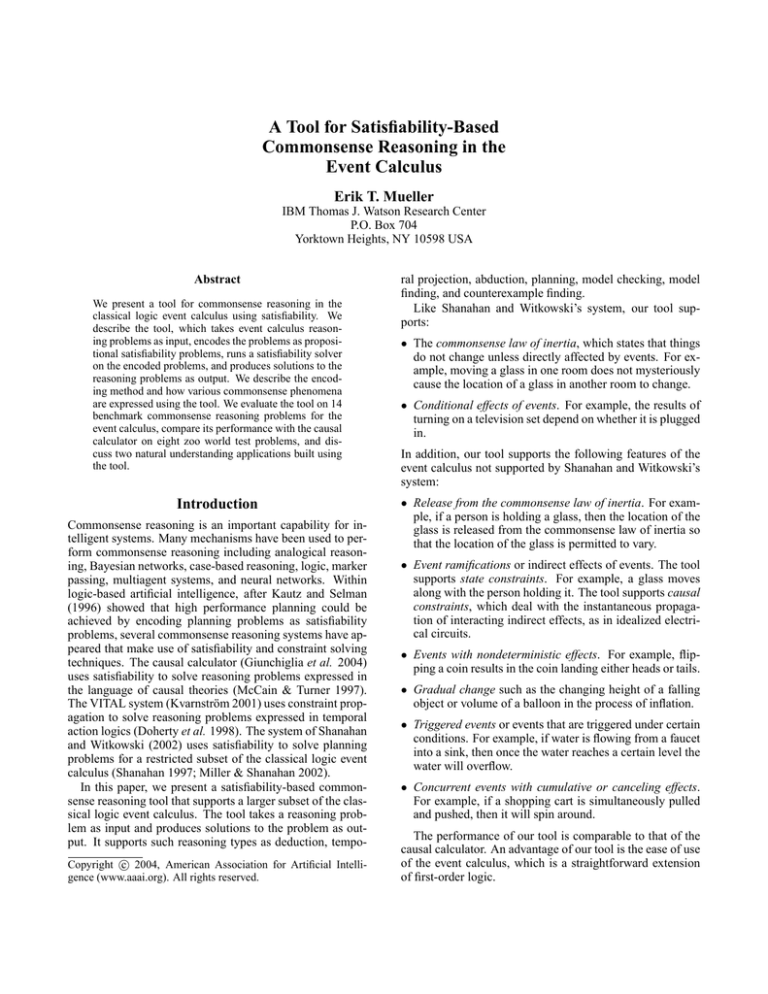
A Tool for Satisfiability-Based
Commonsense Reasoning in the
Event Calculus
Erik T. Mueller
IBM Thomas J. Watson Research Center
P.O. Box 704
Yorktown Heights, NY 10598 USA
Abstract
We present a tool for commonsense reasoning in the
classical logic event calculus using satisfiability. We
describe the tool, which takes event calculus reasoning problems as input, encodes the problems as propositional satisfiability problems, runs a satisfiability solver
on the encoded problems, and produces solutions to the
reasoning problems as output. We describe the encoding method and how various commonsense phenomena
are expressed using the tool. We evaluate the tool on 14
benchmark commonsense reasoning problems for the
event calculus, compare its performance with the causal
calculator on eight zoo world test problems, and discuss two natural understanding applications built using
the tool.
Introduction
Commonsense reasoning is an important capability for intelligent systems. Many mechanisms have been used to perform commonsense reasoning including analogical reasoning, Bayesian networks, case-based reasoning, logic, marker
passing, multiagent systems, and neural networks. Within
logic-based artificial intelligence, after Kautz and Selman
(1996) showed that high performance planning could be
achieved by encoding planning problems as satisfiability
problems, several commonsense reasoning systems have appeared that make use of satisfiability and constraint solving
techniques. The causal calculator (Giunchiglia et al. 2004)
uses satisfiability to solve reasoning problems expressed in
the language of causal theories (McCain & Turner 1997).
The VITAL system (Kvarnström 2001) uses constraint propagation to solve reasoning problems expressed in temporal
action logics (Doherty et al. 1998). The system of Shanahan
and Witkowski (2002) uses satisfiability to solve planning
problems for a restricted subset of the classical logic event
calculus (Shanahan 1997; Miller & Shanahan 2002).
In this paper, we present a satisfiability-based commonsense reasoning tool that supports a larger subset of the classical logic event calculus. The tool takes a reasoning problem as input and produces solutions to the problem as output. It supports such reasoning types as deduction, tempoc 2004, American Association for Artificial IntelliCopyright gence (www.aaai.org). All rights reserved.
ral projection, abduction, planning, model checking, model
finding, and counterexample finding.
Like Shanahan and Witkowski’s system, our tool supports:
• The commonsense law of inertia, which states that things
do not change unless directly affected by events. For example, moving a glass in one room does not mysteriously
cause the location of a glass in another room to change.
• Conditional effects of events. For example, the results of
turning on a television set depend on whether it is plugged
in.
In addition, our tool supports the following features of the
event calculus not supported by Shanahan and Witkowski’s
system:
• Release from the commonsense law of inertia. For example, if a person is holding a glass, then the location of the
glass is released from the commonsense law of inertia so
that the location of the glass is permitted to vary.
• Event ramifications or indirect effects of events. The tool
supports state constraints. For example, a glass moves
along with the person holding it. The tool supports causal
constraints, which deal with the instantaneous propagation of interacting indirect effects, as in idealized electrical circuits.
• Events with nondeterministic effects. For example, flipping a coin results in the coin landing either heads or tails.
• Gradual change such as the changing height of a falling
object or volume of a balloon in the process of inflation.
• Triggered events or events that are triggered under certain
conditions. For example, if water is flowing from a faucet
into a sink, then once the water reaches a certain level the
water will overflow.
• Concurrent events with cumulative or canceling effects.
For example, if a shopping cart is simultaneously pulled
and pushed, then it will spin around.
The performance of our tool is comparable to that of the
causal calculator. An advantage of our tool is the ease of use
of the event calculus, which is a straightforward extension
of first-order logic.
!
&
|
->
<->
[ ]
{ }
logical negation (NOT, ¬)
conjunction (AND, ∧)
disjunction (OR, ∨)
implication (→)
bi-implication (↔)
universal quantification (∀)
existential quantification (∃)
Table 1: Symbols used in formulas
A Simple Example
Suppose we wish to represent the knowledge that waking up
causes a person to be awake, and then use this to deduce that
if James is asleep and wakes up, then James will be awake.
We create the following problem description:
sort actor
fluent Awake(actor)
event WakeUp(actor)
[actor,time] Initiates(WakeUp(actor),Awake(actor),time).
actor James
!HoldsAt(Awake(James),0).
Happens(WakeUp(James),0).
range time 0 1
We represent the knowledge about waking up: We define a
sort actor to represent a person or animal. We define a fluent
Awake and an event WakeUp. We add an Initiates axiom that
states that if an actor wakes up, then the actor will be awake.
The tool uses a formula syntax similar to that of the Bliksem
resolution theorem prover (de Nivelle 1999). Table 1 shows
the symbols used in formulas. Then we represent a narrative
about James: We define a constant James whose sort is actor. We state that James is not awake at time step 0 and that
he wakes up at time step 0. We state that reasoning should
be limited to time points 0 through 1.
When we run the tool on this problem description, it produces:
5 variables and 9 clauses
1 model
--model 1:
0
Happens(WakeUp(James), 0).
1
+Awake(James).
encoding 0.0s, solution 0.0s
The tool finds one solution or model in which James is
awake at time step 1. For each model the tool shows the
fluents that are true at time point 0 (none in this case). Thereafter, the tool indicates fluents that become true with a plus
sign and fluents that become false with a minus sign. The
tool shows event occurrences at the end of each time point.
The tool shows the number of variables and clauses of the
satisfiability encoding of the problem, and the time taken to
encode and solve the problem. When the tool does not find
any models, it provides a near miss solution along with unsatisfied clauses to help with debugging.
The Classical Logic Event Calculus
The classical logic event calculus (Shanahan 1999a) is a reformulation in many-sorted first-order logic of the original
event calculus (Kowalski & Sergot 1986). Following Shanahan and Witkowski (2002), we restrict the event calculus to
finite sets of variables, constants, function symbols, predicate symbols, and sorts. A finite set of time points is associated with the time sort.
The predicate symbols of the event calculus are as follows:
1. Happens(event, time): event occurs at time.
2. HoldsAt(fluent, time): fluent is true at time.
3. ReleasedAt(fluent, time): fluent is released from the commonsense law of inertia at time.
4. Initiates(event, fluent, time): if event occurs at time, then
fluent becomes true at time+1 and is no longer released
from the commonsense law of inertia at time+1.
5. Terminates(event, fluent, time): if event occurs at time,
then fluent becomes false at time+1 and is no longer released from the commonsense law of inertia at time+1.
6. Releases(event, fluent, time): if event occurs at time, then
fluent becomes released from the commonsense law of inertia at time+1.
7. Trajectory(fluent1, time, fluent2, offset): if fluent1 is initiated by an event that occurs at time, and offset is greater
than zero, then fluent2 is true at time+offset.
A paper by Miller and Shanahan (2002) presents an axiomatization of the event calculus as well as a number of
alternative axiomatizations that subtract or add various features. Our tool supports a formulation that combines axioms
from the paper’s Section 3.2 (for a version of the event calculus in which initiating and terminating a fluent at the same
time produces inconsistency), Section 3.5 (gradual change),
and Section 3.7 (release from the commonsense law of inertia).
Satisfiability Encoding Method
We now explain the method used by our tool to encode reasoning problems as satisfiability problems. We will be forming a conjunction of problem formulas.
First, we apply syntactic transformations to any input formulas containing the predicate symbols Initiates,
Terminates, Releases, or Trajectory.
These transformations serve to eliminate atoms involving these predicates which if retained would result in extremely large
satisfiability problems.
For example, the atom Initiates(event,fluent,time) would give rise to number-of-eventground-terms × number-of-fluent-ground-terms × numberof-time-points ground atoms. We add the transformed formulas to the conjunction of problem formulas. In the above
simple example, we transform:
[actor,time] Initiates(WakeUp(actor),Awake(actor),time).
into:
[actor,time]
Happens(WakeUp(actor),time) ->
HoldsAt(Awake(actor),time+1) &
!ReleasedAt(Awake(actor),time+1).
Second, we add to the conjunction of problem formulas
any input formulas not transformed above. In our simple
example, we add:
!HoldsAt(Awake(James),0).
Happens(WakeUp(James),0).
Third, we complete the Happens predicate in the conjunction of problem formulas, using standard techniques (Clark
1978, pp. 303–305). This rules out extraneous events (Davis
1990, p. 208) or event occurrences neither explicitly asserted nor triggered by conditions.
Fourth, in order to enforce the commonsense law of inertia, we generate explanation closure frame axioms (Haas
1987) from Initiates, Terminates, and Releases axioms and
add them to the conjunction of problem formulas. Explanation closure frame axioms specify for each fluent all the
events that can cause the fluent’s truth value to change.
Frame axioms are not generated for fluents declared as noninertial or always released from the commonsense law of
inertia. We generate frame axioms using a technique similar
to that described by Reiter (2001, pp. 28–32). He described
the technique for the situation calculus; we have adapted it
to the event calculus. We have also added a disjunct that enables fluents to be released from the commonsense law of
inertia. In our simple example, we add the following frame
axioms:
[actor,time]
HoldsAt(Awake(actor),time+1) ->
HoldsAt(Awake(actor),time)|
ReleasedAt(Awake(actor),time+1)|
Happens(WakeUp(actor),time).
[actor,time]
!HoldsAt(Awake(actor),time+1) ->
!HoldsAt(Awake(actor),time)|
ReleasedAt(Awake(actor),time+1).
The first axiom states that if an actor is awake at time+1,
then either (1) the actor was awake at time, (2) the fluent
Awake is released from the commonsense law of inertia at
time+1, or (3) the actor woke up at time. The second axiom
states that if an actor is not awake at time+1, then either the
actor was not awake at time or Awake is released from the
commonsense law of inertia at time+1. The second axiom
does not contain a Happens atom because no Terminates axioms were specified for the Awake fluent in the problem description. In addition, we add frame axioms for ReleasedAt:
[actor,time]
ReleasedAt(Awake(actor),time+1) ->
ReleasedAt(Awake(actor),time).
[actor,time]
!ReleasedAt(Awake(actor),time+1) ->
!ReleasedAt(Awake(actor),time)|
Happens(WakeUp(actor),time).
We also add the initial conditions for ReleasedAt:
[actor] !ReleasedAt(Awake(actor),0).
Fifth, we transform the conjunction of problem formulas
into a propositional calculus formula by instantiating quantifiers, simplifying, and converting to short conjunctive normal form by renaming subformulas (Plaisted & Greenbaum
1986). In our simple example, we end up with the following
nine clauses:
HoldsAt(Awake(James),1)|!Happens(WakeUp(James),0).
!Happens(WakeUp(James),0)|!ReleasedAt(Awake(James),1).
!HoldsAt(Awake(James),0).
Happens(WakeUp(James),0).
Happens(WakeUp(James),0)|ReleasedAt(Awake(James),1)|
HoldsAt(Awake(James),0)|!HoldsAt(Awake(James),1).
HoldsAt(Awake(James),1)|ReleasedAt(Awake(James),1)|
!HoldsAt(Awake(James),0).
ReleasedAt(Awake(James),0)|!ReleasedAt(Awake(James),1).
Happens(WakeUp(James),0)|ReleasedAt(Awake(James),1)|
!ReleasedAt(Awake(James),0).
!ReleasedAt(Awake(James),0).
The above clauses are, in order, the transformed Initiates axiom, the input formulas that were not transformed, the frame
axioms, and the ReleasedAt initial condition.
Finally, we map ground atoms to new variables of the satisfiability problem:
Happens(WakeUp(James),0) → 1
HoldsAt(Awake(James),1)
→2
ReleasedAt(Awake(James),1)→ 3
HoldsAt(Awake(James),0)
→4
ReleasedAt(Awake(James),0)→ 5
The encoding method is implemented in C and consists of
4,144 lines of code. The method is described in more detail
elsewhere (Mueller 2004b).
The encoding method is used by the tool as follows: We
format the encoded problem in the standard DIMACS format for satisfiability problems:
p cnf 5 9
2 -1 0
-1 -3 0
-4 0
1 0
1 3 4 -2 0
2 3 -4 0
5 -3 0
1 3 -5 0
-5 0
We pass the problem to an off-the-shelf satisfiability solver.
Our tool uses the Relsat (Bayardo Jr. & Schrag 1997) complete satisfiability solver. In order to find near miss solutions
when there are no models, it uses Walksat (Selman, Kautz,
& Cohen 1993). For each solution produced by the solver:
Solution 1:
1 2
we convert the solution back into a list of ground atoms by
mapping true variables back to true ground atoms and false
variables back to false ground atoms. We map the above solution back to:
Happens(WakeUp(James),0)
HoldsAt(Awake(James),1)
!ReleasedAt(Awake(James),1)
!HoldsAt(Awake(James),0)
!ReleasedAt(Awake(James),0)
Expressing Commonsense Phenomena
We now explain how various commonsense phenomena are
expressed in the event calculus using the tool. We express
conditional effects of events using axioms of the form:
condition → Initiates(event, fluent, time)
condition → Terminates(event, fluent, time)
where a condition is a conjunction of inequalities and atoms
of the form HoldsAt(β, time) or ¬HoldsAt(β, time). For example, we may specify that if a television set is turned on,
then it will go on only if it is plugged in:
For example, we might know that moving involves either
driving or running. If an actor runs, the actor gets tired. But
if we are told simply that an actor moved, whether the actor
will be tired is nondeterministic. We express this as follows:
[actor,switch,tv,time]
TVOf(switch)=tv & HoldsAt(PluggedIn(tv),time) ->
Initiates(TurnOn(actor,switch),TVOn(tv),time).
[actor,time]
Happens(Move(actor),time) ->
Happens(Run(actor),time)|Happens(Drive(actor),time).
xor Run, Drive
[actor,time] Initiates(Run(actor),Tired(actor),time).
One way of expressing event ramifications is with state
constraints, which are of the form:
condition1 ↔ condition2
condition1 → condition2
For example, we may specify that a switch is Off whenever
it is not On:
noninertial Off
[switch,time] HoldsAt(Off(switch),time) <->
!HoldsAt(On(switch),time).
In this case, Off is always released from the commonsense
law of inertia and always depends on On.
We may specify that fluents are only sometimes released
from the commonsense law of inertia using axioms of the
form:
condition → Releases(event, fluent, time)
For example, we may specify that picking up an object releases its location:
[actor,physobj,location,time]
Releases(PickUp(actor,physobj),At(physobj,location),time).
Then we may use a state constraint to express that when an
actor is holding an object, the location of the object depends
on the location of the actor:
[actor,location,physobj,time]
HoldsAt(Holding(actor,physobj),time) &
HoldsAt(At(actor,location),time) ->
HoldsAt(At(physobj,location),time).
Finally, when an actor sets down an object, the location of
the object will no longer be released from the commonsense
law of inertia:
[actor,physobj,location,time]
HoldsAt(At(actor,location),time) ->
Initiates(SetDown(actor,physobj),At(physobj,location),time).
We may also express event ramifications with causal constraints by adding four new predicates and four new axioms
to the formulation of the event calculus, as described by
Shanahan (1999b).
One method for expressing events with nondeterministic
effects uses a determining fluent, whose value determines
the result of an event. We may specify that when a wheel is
spun, it takes on one of several values at random:
noninertial WheelValueDeterminingFluent
[wheel,value,time]
HoldsAt(WheelValueDeterminingFluent(wheel,value),time) ->
Initiates(Spin(wheel),WheelValue(wheel,value),time).
range value 7 10
Another method for expressing events with nondeterministic effects uses disjunctive event axioms, which are of the
form:
Happens(event, time) →
Happens(event1, time) ∨ . . . ∨ Happens(eventn, time)
We express gradual change with axioms of the form:
condition → Trajectory(fluent1, time, fluent2, offset)
For example, we might specify that n time points after an
object starts falling, its height is n2 less than it was when it
started falling:
[object,time]
Initiates(StartFalling(object),Falling(object),time).
[object,height,time]
Releases(StartFalling(object),Height(object,height),
time).
[object,height1,height2,offset,time]
HoldsAt(Height(object,height1),time) &
height2=height1-offset*offset ->
Trajectory(Falling(object),time,
Height(object,height2),offset).
[object,height1,height2,time]
HoldsAt(Height(object,height1),time) &
HoldsAt(Height(object,height2),time) ->
height1=height2.
We express events that are triggered under certain conditions using axioms of the form:
condition → Happens(event, time)
For example, we may extend the above example with a collision event that is triggered when the falling object hits the
ground. The collision event stops the object from falling and
the height of the object will no longer be released from the
commonsense law of inertia:
[object,time]
HoldsAt(Falling(object),time) &
HoldsAt(Height(object,0),time) ->
Happens(HitsGround(object),time).
[object,time]
Terminates(HitsGround(object),Falling(object),time).
[object,height,time]
HoldsAt(Height(object,height),time) ->
Initiates(HitsGround(object),Height(object,height),time).
Given the above example and the narrative:
!HoldsAt(Falling(Leaf),0).
HoldsAt(Height(Leaf,4),0).
Happens(StartFalling(Leaf),0).
the tool produces:
0
Height(Leaf, 4).
Happens(StartFalling(Leaf), 0).
1
Problem
B US R IDE
C HESS B OARD
C OIN T OSS
C OMMUTER
D EAD O R A LIVE
H APPY
K ITCHEN S INK
RUSSIAN T URKEY
S TOLEN C AR
S TUFFY ROOM
S UPERMARKET
T HIELSCHER C IRCUIT
WALKING T URKEY
YALE
Vars
30
27
24
—
36
24
102
35
10
27
104
68
—
28
Clauses
74
52
65
—
76
46
593
87
20
57
752
142
—
64
Table 2: Results on event calculus benchmark problems
-Height(Leaf, 4).
+Falling(Leaf).
+Height(Leaf, 3).
2
-Height(Leaf, 3).
+Height(Leaf, 0).
Happens(HitsGround(Leaf), 2).
3
-Falling(Leaf).
We express concurrent events with cumulative or canceling effects using axioms of the form:
incident → Initiates(event, fluent, time)
incident → Terminates(event, fluent, time)
where an incident is a conjunction of atoms of the form
Happens(α, time) or ¬Happens(α, time). For example, we
may specify that the result of approval by itself is happiness,
while the result of simultaneous approval and disapproval is
confusion and not happiness:
[actor1,actor2,time]
!Happens(DisapproveOf(actor1,actor2),time) ->
Initiates(ApproveOf(actor1,actor2),Happy(actor2),time).
[actor1,actor2,time]
Happens(DisapproveOf(actor1,actor2),time) ->
Initiates(ApproveOf(actor1,actor2),Confused(actor2),time).
Evaluation on Event Calculus Problems
As shown in Table 2, our tool solves 12 of the 14 benchmark
commonsense reasoning problems that have been described
for the event calculus by Shanahan (1997; 1999a). All of the
problems are solved in less than one second. C OMMUTER
involves compound events and WALKING T URKEY involves
effect constraints; these features are not supported by our
tool.
Causal Calculator Performance Comparison
We now compare the performance of our tool and the causal
calculator (CCALC) in an important benchmark domain, the
zoo world proposed by Erik Sandewall and formalized in
the language of CCALC (Akman et al. 2004). We translated the CCALC formalization of the zoo world into the
Problem
Z OOT EST 1
c
Z OOT EST 2
c
Z OOT EST 3
c
Z OOT EST 4.1
c
Z OOT EST 4.2
c
Z OOT EST 5.1
c
Z OOT EST 5.2
c
Z OOT EST 6
c
Vars
3,239
2,693
982
1,116
1,805
1,726
3,239
2,770
3,980
3,292
1,670
1,483
1,670
1,483
1,088
1,127
Clauses
23,819
31,881
5,671
8,870
12,604
17,895
23,816
32,193
29,572
39,354
12,906
18,120
12,908
18,122
6,996
10,428
Encode
23.35
14.83
1.86
3.67
8.74
15.08
23.22
14.98
34.24
14.90
21.92
44.69
22.11
44.69
4.02
14.85
Solve
1.18
12.24
0.14
0.17
0.53
0.61
1.19
4.14
1.39
11.54
1.50
5.04
0.66
5.06
0.30
1.10
Table 3: Comparison with CCALC (c) on zoo problems
(wall times in seconds)
event calculus, and used our tool to solve the same set of
zoo world test problems solved by CCALC. The CCALC
formalization consists of 62 causal laws and our event calculus translation consists of 78 axioms. As shown in Table 3,
the performance of our tool on the test problems is comparable to that of CCALC. The CCALC runs were performed
with CCALC 2.0 beta 8.3, SWI-Prolog 5.0.10, and Relsat
2.0. The CCALC encoding time is the sum of the grounding and completion times. Encoding and solution times reported in this paper are elapsed wall-clock time in seconds
on a machine with a 1.8 GHz Intel Pentium 4 processor and
512 megabytes of RAM.
Natural Language Applications
In addition to solving benchmark problems, our tool is useful for real-world applications. It provides an effective
mechanism for carrying out inferences and filling in missing
information in natural language understanding applications
(Mueller 2003). The tool has been used to build two applications that expand a semantic parse of a narrative text into
a more detailed model of the narrative. Questions about the
narrative are then answered by consulting the model.
A commonsense knowledge base has been developed for
use with our tool, which is used by the two applications. The
knowledge base consists of 445 axioms.
The first application (Mueller 2004a) used the tool to
build models of terrorist incidents given arbitrary templates
of the sort produced by MUC3 and MUC4 information extraction systems. The application produced models for 652
terrorism templates. It generated questions and answers
such as the following:
Q: Were the villagers angry at the unidentified persons
after the unidentified persons threatened the villagers?
A: Yes.
Q: Was the grocery store intact after the fire damaged
the grocery store?
A: No.
Problem
A RSON
K IDNAPPING
S HOOTING ATTACK
B OMBING
Vars
1,010
5,553
1,933
8,258
Clauses
4,765
27,070
10,138
40,277
Encode
1.03
19.86
3.28
44.79
Solve
0.09
0.91
0.28
1.90
Table 4: Terrorist incident understanding statistics (wall
times in seconds)
Q: Were the unidentified persons present when the fire
damaged the grocery store?
A: Yes.
Table 4 provides statistics on processing typical reasoning
problems for each type of terrorist incident.
The second application (Mueller 2004c) used information
extraction techniques to extract episodes involving dining in
a restaurant from narrative texts, used the tool to build models of the dining episodes, and generated questions and answers about the episodes. The application produced models
for 61 web texts and 52 American literature excerpts. A
typical reasoning problem had 5,160 variables and 43,205
clauses, was encoded in 25.40 seconds, and was solved in
1.32 seconds.
Conclusions
We have presented a tool for automated commonsense reasoning in the classical logic event calculus. The tool works
by converting a first-order logic problem into propositional
logic, invoking an off-the-shelf satisfiability solver on the
propositional logic problem, and then decoding the solutions
produced by the solver. The tool successfully solves 12 of
14 benchmark commonsense reasoning problems described
for the event calculus, has performance comparable to the
causal calculator in the zoo world domain, and has been used
to perform inferencing in two natural language understanding applications.
References
Akman, V.; Erdogan, S. T.; Lee, J.; Lifschitz, V.; and
Turner, H. 2004. Representing the zoo world and the traffic world in the language of the causal calculator. Artificial
Intelligence 153:105–140.
Bayardo Jr., R. J., and Schrag, R. C. 1997. Using CSP
look-back techniques to solve real world SAT instances. In
Proceedings of AAAI-1997, 203–208. Menlo Park, CA:
AAAI Press.
Clark, K. L. 1978. Negation as failure. In Gallaire, H.,
and Minker, J., eds., Logic and Data Bases. New York:
Plenum. 293–322.
Davis, E. 1990. Representations of Commonsense Knowledge. San Mateo, CA: Morgan Kaufmann.
de Nivelle, H. 1999. Bliksem 1.10 user manual.
Doherty, P.; Gustafsson, J.; Karlsson, L.; and Kvarnström,
J. 1998. TAL: Temporal Action Logics language specification and tutorial. Linköping Electronic Articles in Computer and Information Science 3(015).
Giunchiglia, E.; Lee, J.; Lifschitz, V.; McCain, N.; and
Turner, H. 2004. Nonmonotonic causal theories. Artificial
Intelligence 153:49–104.
Haas, A. R. 1987. The case for domain-specific frame axioms. In Brown, F. M., ed., The Frame Problem in Artificial
Intelligence, 343–348. Los Altos, CA: Morgan Kaufmann.
Kautz, H., and Selman, B. 1996. Pushing the envelope:
Planning, propositional logic, and stochastic search. In
Proceedings of AAAI-1996, 1194–1201. Menlo Park, CA:
AAAI Press.
Kowalski, R. A., and Sergot, M. J. 1986. A logic-based
calculus of events. New Generation Computing 4(1):67–
95.
Kvarnström, J. 2001. VITAL: Visualization and implementation of temporal action logic.
McCain, N., and Turner, H. 1997. Causal theories of action and change. In Proceedings of AAAI-1997, 460–465.
Menlo Park, CA: AAAI Press.
Miller, R., and Shanahan, M. 2002. Some alternative formulations of the event calculus. In Lecture Notes in Computer Science, volume 2408. Heidelberg: Springer-Verlag.
452–490.
Mueller, E. T. 2003. Story understanding through multirepresentation model construction. In Hirst, G., and Nirenburg, S., eds., Text Meaning: Proceedings of the HLTNAACL 2003 Workshop, 46–53. East Stroudsburg, PA: Association for Computational Linguistics.
Mueller, E. T. 2004a. Combining information extraction and commonsense reasoning for text understanding.
Manuscript submitted for publication.
Mueller, E. T. 2004b. Event calculus reasoning through
satisfiability. Manuscript submitted for publication.
Mueller, E. T. 2004c. Modelling space and time in narratives about restaurants. Manuscript submitted for publication.
Plaisted, D. A., and Greenbaum, S. 1986. A structurepreserving clause form translation. Journal of Symbolic
Computation 2:293–304.
Reiter, R. 2001. Knowledge in Action. Cambridge, MA:
MIT Press.
Selman, B.; Kautz, H.; and Cohen, B. 1993. Local search
strategies for satisfiability testing. In DIMACS Series in
Discrete Mathematics and Theoretical Computer Science,
volume 26. Boston, MA: American Mathematical Society.
Shanahan, M., and Witkowski, M. 2002. Event calculus
planning through satisfiability. Manuscript submitted for
publication.
Shanahan, M. 1997. Solving the Frame Problem. Cambridge, MA: MIT Press.
Shanahan, M. 1999a. The event calculus explained. In Lecture Notes in Computer Science, volume 1600. Heidelberg:
Springer-Verlag. 409–430.
Shanahan, M. 1999b. The ramification problem in the
event calculus. In Proceedings of IJCAI-1999, 140–146.
San Mateo, CA: Morgan Kaufmann.

